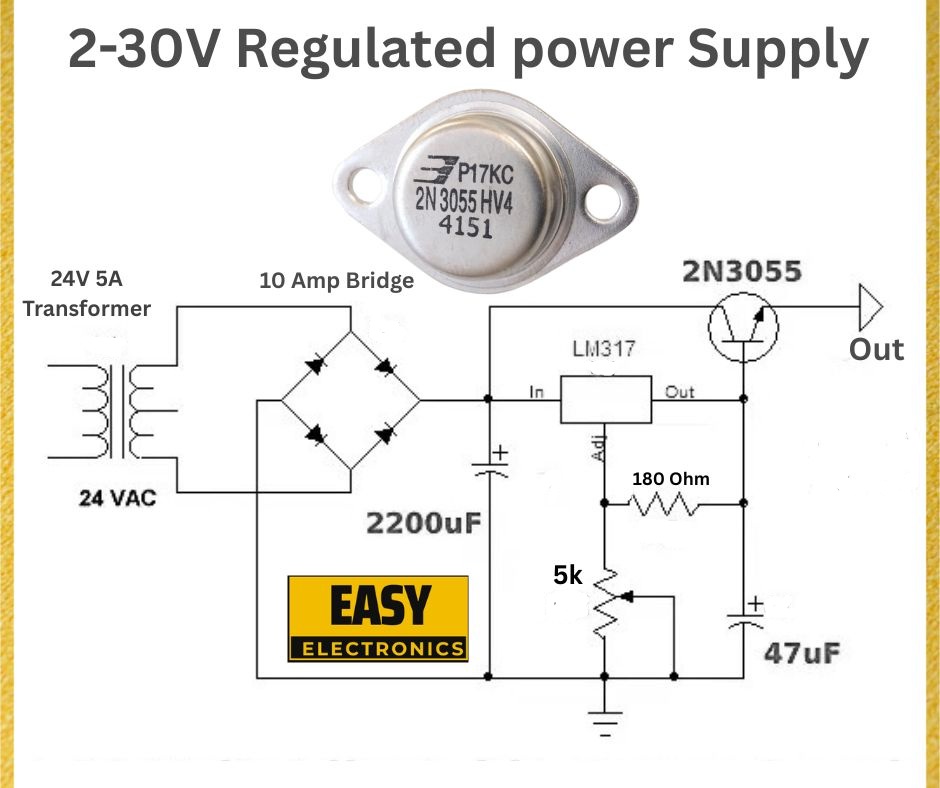Introduction to Variable DC Power Supplies
A 2-30V regulated DC power supply is a versatile tool for electronics hobbyists, engineers, and students. It provides a stable, adjustable voltage output for testing circuits, powering devices, or prototyping projects. This article dives into a simple yet effective design using the LM317 regulator and 2N3055 transistor, offering a detailed analysis, component breakdown, and practical tips for building your power supply.
Circuit Overview: How Does a 2-30V Power Supply Work?
This circuit converts a 24V AC input into a regulated DC output adjustable from 2V to 30V. It uses a transformer, bridge rectifier, and a combination of the LM317 voltage regulator and 2N3055 power transistor to achieve stable voltage regulation with a decent current capacity.
Key Components of the 2-30V Power Supply Circuit
- Transformer (24V, 5A):
- Steps down the AC mains voltage to 24V AC.
- Rated at 5A, it supports moderate current demands, making the circuit suitable for various applications.
- 10A Bridge Rectifier:
- A full-wave bridge rectifier converts the 24V AC to pulsating DC.
- Rated for 10A, it ensures the circuit can handle high currents without overheating.
- Smoothing Capacitor (2200µF):
- Filters the pulsating DC into a smoother DC voltage.
- The 2200µF capacitance is sufficient to reduce ripple for a 5A load, though the exact voltage rating isn’t specified (should be at least 35V to handle the peak rectified voltage of 24V × √2 ≈ 34V).
- LM317 Voltage Regulator:
- The LM317 is a popular adjustable voltage regulator capable of outputting 1.25V to 37V.
- It sets the output voltage based on the resistor network connected to its ADJ pin.
- 2N3055 Power Transistor:
- A high-power NPN transistor rated for 60V and 15A.
- It boosts the current handling capacity of the LM317, which is typically limited to 1.5A.
- Resistors (180Ω and 5kΩ Potentiometer):
- The 180Ω resistor and 5kΩ potentiometer form a voltage divider that sets the LM317’s output voltage.
- Adjusting the potentiometer changes the voltage at the ADJ pin, allowing the output to vary from 2V to 30V.
- Output Capacitor (47µF):
- Reduces noise and improves transient response at the output.
- A 47µF capacitor is a common choice for stabilizing the output voltage.

How the 2-30V Regulated Power Supply Works
- AC to DC Conversion:
- The 10A bridge rectifier rectifies the 24V AC from the transformer into a pulsating DC voltage.
- The 2200µF capacitor smooths this voltage, providing a stable DC input to the regulator circuit.
- Voltage Regulation with LM317:
- The LM317 maintains a constant 1.25V difference between its OUT and ADJ pins.
- The formula determines the output voltage:
V_out = 1.25 × (1 + R2/R1), where R1 is the 180Ω resistor, and R2 is the 5kΩ potentiometer. - Adjusting the potentiometer changes R2, allowing the output to range from approximately 2V (minimum resistance) to 30V (maximum resistance).
- Current Boost with 2N3055:
- The LM317 alone cannot handle high currents. The 2N3055 transistor is connected as a pass element, allowing the circuit to deliver up to 5A (limited by the transformer and transistor ratings).
- The LM317 controls the base of the 2N3055, ensuring the output voltage remains regulated even under load.
Practical Tips for Building a 2-30V Power Supply
- Heat Management:
- The 2N3055 and LM317 will generate significant heat, especially at high currents or large voltage drops. Mount both heatsinks to prevent thermal shutdown.
- For example, at 5A and a 20V drop across the 2N3055, power dissipation is P = V × I = 20V × 5A = 100W, requiring a robust heatsink.
- Component Ratings:
- Ensure the 2200µF capacitor is rated for at least 35V to handle the rectified voltage.
- The 2N3055 is rated for 60V, which is sufficient for a 30V output, but adding a margin (e.g., using a transistor rated for 100V) can improve reliability.
- Safety Features:
- Add a fuse on the transformer’s primary side to protect against short circuits.
- Include an overcurrent protection circuit to safeguard the 2N3055 and LM317.
- Calibration:
- After assembly, use a multimeter to calibrate the output voltage. Adjust the potentiometer to confirm the range from 2V to 30V.
Applications of a 2-30V Regulated Power Supply
- Circuit Testing: Provides adjustable voltage for testing various electronic components.
- DIY Projects: Powers motors, LEDs, or microcontrollers with precise voltage control.
- Educational Use: Ideal for learning about voltage regulation and power supply design.
Conclusion
This 2-30V regulated power supply circuit, built around the LM317 and 2N3055, offers a simple and effective solution for adjustable voltage needs. With a current capacity of up to 5A and a wide voltage range, it’s perfect for hobbyists and professionals alike. By following the design tips and ensuring proper heat management, you can build a reliable power supply for your electronics projects.
Keywords
- 2-30V power supply circuit
- LM317 voltage regulator
- 2N3055 transistor
- Adjustable DC power supply
- DIY electronics projects
